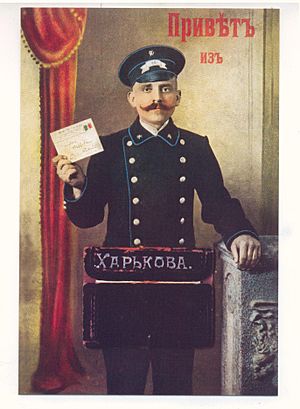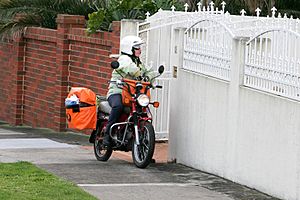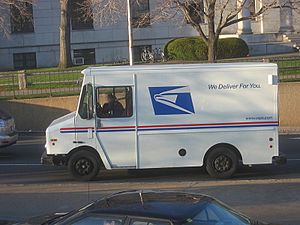Mail carrier facts for kids
A mail carrier is a person who works for a post office or postal service. Their main job is to deliver mail and packages to homes and businesses. You might also hear them called a mailman, mailwoman, postman, or postwoman. In places like Australia and New Zealand, they are often called a postie. The term "mail carrier" became popular because it can be used for both men and women.
Contents
Mail Carriers in the United States
In the United States, there are different kinds of mail carriers, each with a slightly different job.
City Letter Carriers
These carriers usually work in cities and towns. Their routes are often busy with many homes and businesses close together. They might drive a special white van with the United States Postal Service logo. They deliver mail to mailboxes at the curb or attached to buildings. Sometimes, they park their vehicle and walk a "loop" of mail, delivering to houses on both sides of the street before returning to their van. This is called "park and loop" delivery.
Rural Carriers
Rural carriers work in areas where homes are farther apart. Their routes cover more miles but have fewer stops. They usually drive their own vehicles and don't always wear a uniform. They mostly deliver to mailboxes from their vehicle. As more rural areas become developed, their routes are starting to look a lot like city routes.
Highway Contract Route Carriers
These carriers work on routes that are very spread out, often in remote areas or small communities. They are independent contractors, meaning they run their own business to deliver the mail. They always use their own vehicles.
Becoming a Mail Carrier
To become a city letter carrier, you usually start as a City Carrier Assistant (CCA). Rural carriers often begin as Rural Carrier Associates (RCA). These starting positions help new carriers learn the job. Highway Contract Route carriers are hired by the person who won the contract for that route.
Women Mail Carriers
Women have been delivering mail in the United States for a long time, starting in the late 1800s. During World War I, more women became city carriers. By 2007, a large number of mail carriers were women, showing how important they are to the postal service.
Related pages
Images for kids
See also
 In Spanish: Cartero para niños
In Spanish: Cartero para niños










